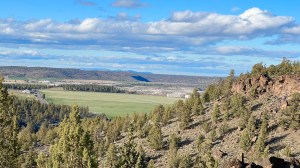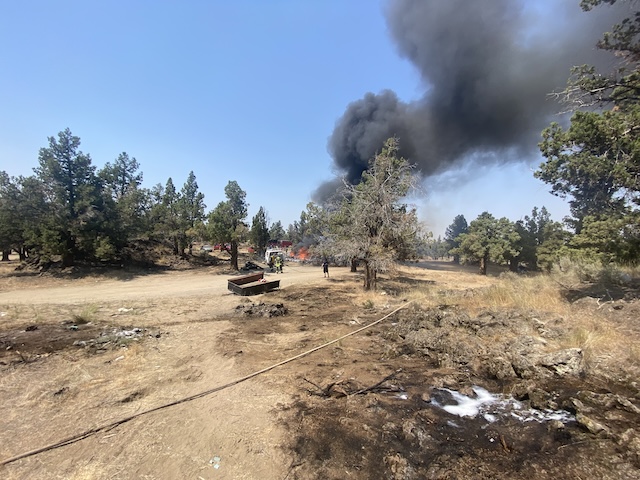More Deschutes County farm-zoned land on path to rural housing
Published 8:00 am Saturday, May 31, 2025

- An aerial photo shows the area of northern Deschutes County where developers plan to build 71 homes across 710 acres now zoned as exclusive farm use. (Ryder Redfield/Central Oregon LandWatch)
Plans to build 71 homes across 710 acres of juniper woodland and shrub steppe in rural Deschutes County moved closer to reality earlier this month after a state board affirmed a Deschutes County decision allowing removal of agricultural zoning protections from the land.
Rezoning the land would pave the way for a massive subdivision carved into the High Desert landscape that developers envision as a model for environmental consciousness and community benefit. But fierce opposition from land use nonprofits and a nearby rancher has ensnared the proposal in a tangle of multi-year appeals hinging on Oregon’s strict system for preventing usable farmland from turning into housing.
Pervaded by rocky, infertile soils and an intense demand for rural housing, Deschutes County has supported developers in allowing more land to be moved from farming-exclusive zones to residential than in any other part of the state. And developers have been largely successful in defending themselves from appeals to higher bodies by building sturdy cases that their lands are no good for farming.
Trending
The 710-acre property is taking the trend to new heights because it is the largest single farm zone change the county has ever considered.
A scenic rural development with community benefits
The property lies between Terrebonne and Sisters a few miles north of U.S. Highway 126. It encompasses about 1 square mile, or roughly half of the size of all the land in the Sisters city limits. It’s surrounded by farmland and some low-density residential development.
Dale Stockamp, whose success building a large healthcare consulting company allowed him to transition to real estate, helped purchase the property in 2020.
“When I saw this property and walked it, and saw the incredible scenery and beauty and view of all of the mountains and that, I thought, ‘this really needs to benefit more people than the one homesite that was sitting there,’” Stockamp said.
The development is called The Peaks 360.
County property records show it is owned by Eden Central Properties LLC, which is registered to Darin Honn, Robert Turner and Charles Thomas, who list addresses in Sisters, Portland and Hawaii.

An aerial photo shows the area of northern Deschutes County where developers plan to build 71 homes across 710 acres now zoned as exclusive farm use. (Caitlyn Burford/Central Oregon LandWatch)
Trending
Stockamp said he doesn’t know yet how much the homes will cost.
Developers have explored many sustainability options, including solar and limiting water use, and improving habitat by removing juniper trees, said Stockamp, who has owned a house in Deschutes County for nearly 30 years. His son, Mark, who leads research and development on the project and also serves on the county’s planning commission, said developers worked with environmental consultants with wide-ranging expertise, including in wildfire risk reduction.
Dale Stockamp, who owns a majority share of the property, said he plans to donate all of his own profits from the development to nonprofits that provide food and furniture for people in need.
One of those is NeighborImpact, a regional basic needs nonprofit. Executive Director Scott Cooper said the Stockamps have been generous donors.
“They seem to do development with heart. That’s a good fit with Central Oregon needs and values,” Cooper said in an email.
But the battle will likely continue as opponents have said they will appeal again.
“All of the expense that we incur in the legal process is less money we’re going to have to give to nonprofits. That’s just sad,” Stockamp said.
Debate over grazing and profits
On May 16, the Oregon Land Use Board of Appeals, a trio of expert land use attorneys, denied the appeals of several groups contesting a county decision made in October in favor of developers. That was the second time the county voted to allow the zone change, with commissioners Tony DeBone and Patti Adair voting in favor and Phil Chang against.
Opponents previously succeeded in finding flaws in the county’s initial approval decision in 2022, which was appealed and sent back to the county by the land use board and the Oregon Court of Appeals. Both said the county didn’t take enough time to consider the testimony of rancher Billy Buchanan, who runs a cattle operation on 40 acres abutting the 710-acre parcel.
To take property out of exclusive farm use status, Oregon law requires proof not only that the land itself is not farmable, but that it would not be helpful in assisting a conjoining farm.
Buchanan, who runs Keystone Natural Beef, argued he would be able to use the huge property to graze his cows and expand his operation. If so, the property would be suitable for farm use — and not eligible under Oregon’s rules to be used for anything other than that.
“There’s 700 acres up there with introduced grasses that could be seasonally grazed,” he said. “That’s really all that’s relevant to the argument.”
Ben Gordon, executive director of Central Oregon Landwatch, a land-use watchdog group that also appealed the development, called the property “quintessential Central Oregon grazing land.”
“Lands just like this have been successfully managed for livestock grazing since cattle and sheep were introduced to the area,” he said in an email.
Proponents of the development have said the opposite. Matt Cyrus, a sixth-generation family farmer near Sisters and member of the county’s planning commission, said the property would only be able to support two or three cattle based on the capacity of nearby federal grazing lands.
“At best, this property is very poor-quality grazing land,” Cyrus said during public testimony last year.
But when it comes to deciding what qualifies as farmland, the issue of whether or not cows would be able to graze the land was less important than the question of whether that operation would be profitable, the state land use board said.
Developers brought in a handful of ranchers who made the case the land would not be a money-maker. They relied heavily on a letter from Rand Campbell, a Bend land use attorney and part owner of ranches in the Willamette Valley, who said the land is not set up for grazing, and it would take a “considerable amount of money” to change that.
The letter made “erroneous assumptions” but nonetheless showed the overwhelming costs associated with grazing on the property, the state land use board said.
The board also found the county had enough evidence to decide impacts of traffic and water use from the housing development wouldn’t significantly impact nearby ranching.
He’s worried the loss of grazing land is hampering the future of beef production in Deschutes County.
Buchanan called the decision “shocking and disappointing.”
“If we start converting pasture into subdivisions … I don’t see that as something that’s sustainable,” he said.
Carol Macbeth, an attorney for LandWatch, said the group believes the decision “poses a threat to working ranch lands across the state and to ranching as part of the Oregon way of life.”
Friction with state agencies
Approval of the huge land conversion has also caused friction with several state agencies.
The Department of Land Conservation and Development, the Department of Fish and Wildlife and the Oregon Department of Agriculture jointly opposed it in a 2022 letter, recommending the lands remain in the farming zone.
But the letter went beyond just the 710-acre property. The state agencies recognized the property has broader implications because it is similar to much of the nonirrigated rural land in Deschutes County. The lands are valuable for open space, recreation, habitat and as buffers for farms and forests, the letter said.
“Many of these same areas are not appropriate for the encouragement of residential development. Remoteness, an absence of basic services and a susceptibility to natural hazards like wildland fire are all reasons why rural areas are not well suited to residential settlement even if they have little value for forestry or agricultural production,” the letter read.
Sadie Carney, a spokesperson for the land use agency, said the agency remains concerned that the state’s definition of farmland be interpreted and applied correctly.
“At this time, we are carefully reviewing the LUBA decision internally,” Carney said.
Deschutes County’s Comprehensive Plan, which guides land-use policy, acknowledges that a large part of Deschutes County is zoned for exclusive farm use, and much of it has poor or marginal soils. The plan states individual landowners have been successful at removing lands from agricultural zoning on a case-by-case basis, as long as they can prove the lands have poor soils and can’t be used for agriculture.
So far, the process has been most commonly used for lands east of Bend, some of which have already been brought into the city’s urban growth boundary.
Central Oregon LandWatch recently appealed the county’s comprehensive plan on the grounds the county is violating state land use policies by encouraging too much development outside of cities, jeopardizing wildlife habitat, open space and increasing wildfire risk.
Another land-use nonprofit appealing the decision, 1,000 Friends of Oregon, has said Oregon’s exclusive farm use zone is slowly eroding, experiencing a “death by 1,000 cuts.”
But state land use board decisions like the 710-acre property case have affirmed that what the county is allowing is permissible under state law, said Peter Gutowsky, the county’s community development director.
Dale Stockamp said, “I think what the opposition really wants is open space. If that’s what they want, Oregon laws need to change.”









